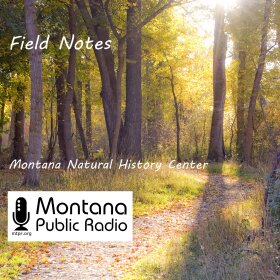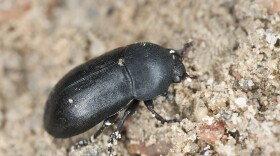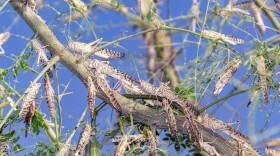
Field Notes
Mon., Wed. Friday at 4:54 p.m.
Nature notes and inquiry from the Montana Natural History Center.
-
In late 2020 I’m spending mornings masked, working in a lab in the University of Montana Zoological Museum. The museum houses research collections of natural artifacts like skins and skeletons. But behind the scenes museum staff tend a single living collection: a colony of dermestid beetles, the meticulous scavengers that scour flesh from bones before a skeleton can be installed in the museum.
-
Why are they so feared and misunderstood? If a bird popularity contest were held, Turkey Vultures would not fare very well. A spooky bird contest, on the other hand? Dead winner.
-
First one, buzzing and bumping into the living room window, who was soon joined by a few sisters. Within an hour, there were more than 40 sinisterly striped yellow jackets (Vespula alascensis) zooming from one window to another in pursuit of light, and I was outnumbered.
-
As I watched Rob Domenech, executive director of the Raptor View Research Institute, and his research biologist Brian Busby carefully load the three chicks onto the lift, and heard Harriet’s chirps of protest from above, I considered the importance of this work.
-
At Lee Metcalf National Wildlife Refuge, I saw an Osprey dive into the deepest section of white water and emerge with nothing to show for its effort, and then retreat to a cottonwood branch to watch for another opportunity in the dark, boiling water.
-
A small spot of orange in the middle of the trail caught my eye. It wasn't a leaf or a berry; it was tiny and moving! As I neared the curious sight, I discovered it was a fuzzy caterpillar.
-
Despite the harsh and stark appearance, all is not lost after a wildfire. In fact, there is much to be found when you look about.
-
Let me take you on a journey. It’s just a few miles, but over that short distance we’ll be transported not only to a dramatically different landscape, but also back through hundreds of millions of years of Earth’s history.
-
The first sound we hear these early summer mornings is the prehistoric, other-worldly call of Sandhill Cranes. It rises deep from their impossibly long necks, climbs into the sky, and stretches for miles across the countryside.
-
We’re wandering around the mostly evergreen woods nearby the ghost town of Garnet, Montana. we reach a sunlit clearing: a bright green patch with just a handful of trees.
-
Usually, pronghorn will dash away when they see a truck coming. However, at times they race toward me, accelerating, seemingly intent on crossing the road ahead of me.
-
My sister and I struggle to keep up with our mother. Today, we carry gallon-sized Ziploc bags, rolling the nearly-black berries from their stems to our palms to our bags.
-
As a teenage boy on the farm in Iowa, I experienced a horde of grasshoppers while unloading a wagon of oats. The surface was covered with grasshoppers! It was not difficult to grab one, and when I did, it would “spit tobacco.” I have since learned that spitting a dark liquid is a defense mechanism. Memories like this one have stuck with me, and in part fueled my interest in the mass of grasshoppers that somehow ended up in Rocky Mountain glaciers.
-
You’ve probably seen it before, even if you didn’t know exactly what you were looking at: some black, woody growth on cherry or plum trees. Black knot fungus, or Apiosporina morbosa, is a fungal agent that invades young trees of the Prunus genus, including most hard-pitted, fruit-bearing trees like cherries, plums, apricots, and peaches.
-
For seven years, I pursued the jay-sized birds on Rattlesnake Creek in Missoula, Montana. That quest to observe a nesting pair turned out to be challenging. Belted kingfishers are loners, skittish, and fiendish to study. However, the rewards of a difficult journey are many—like finding something never recorded before.
-
Straightening the quilt on one of the cots, I glimpsed movement through a window and rushed - barefoot - to the narrow deck to see what it was: a herd of 200 elk galloping along each rise and dip of the valley below the treehouse.
-
Spending time in nature with its wild creatures has always been a way for me to rejuvenate my creativity, to fill my soul with happiness, tranquility, and relaxation. A way to let go of stress and worries, even for just a little bit. Recently I wondered how I could give back to the wildlife that makes itself at home around our five acres, to help it co-exist and thrive. Wanting to keep this little ecosystem as natural as possible, I came across the web page of the National Wildlife Federation’s Garden For Wildlife.
-
Mountain goats, which aren’t actually goats but are considered “goat-antelopes” and whose closest relatives live in the Himalayas, prefer to live above the treeline and in high alpine meadows, beyond the usual range of predators like mountain lions. Beyond the range of many humans, too. They are one of the least-studied large mammals in North America.
-
I was ahead of my husband when I spotted a bear standing in clear view, close by on the gentle slope that led away from the trail. I stopped and smiled as my brain tried to make sense of why the bear was so short and broad…and why were its legs and back darker than its tawny sides? My jaw dropped when the synapses connected. It wasn’t a bear. It was a wolverine!
-
One June about seven years ago, my husband brought home a bitterroot plant. It was stuck to his irrigation shovel by the clay soil from the hay fields near our house in the Helmville Valley. I marveled at the beautiful hot pink blooms and planted them in the flower bed, where they rarely reappeared.
-
Early in April, I had just spied a fox squirrel eating pine seeds from a ground cache when I felt a shadow gliding overhead on silent wings. I looked up yet saw nothing. When I looked back, there was an indistinct gray form, an apparition, in the shadows where the squirrel had been. The apparition turned its head toward me and peered with two large golden eyes. Tufted horns now held erect confirmed it was a Great Horned Owl.
-
What do tree swallows, starlings, pigeons, hummingbirds, and mallard ducks all have in common? Besides being birds, of course, each of these species sports iridescent feathers that glimmer and shine when the light hits them.






















